North Eastern Railway (United Kingdom)
The North Eastern Railway (NER) was an English railway company. It was incorporated in 1854 by the combination of several existing railway companies. Later, it was amalgamated with other railways to form the London and North Eastern Railway at the Grouping in 1923. Its main line survives to the present day as part of the East Coast Main Line between London and Edinburgh.
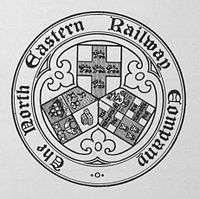 | |
A map of the North Eastern Railway circa. 1900 displayed at York railway station | |
| Overview | |
|---|---|
| Headquarters | York |
| Reporting mark | NE |
| Locale | North East England, Yorkshire |
| Dates of operation | 1854–31 December 1922 |
| Predecessor | York, Newcastle and Berwick Railway York and North Midland Railway Leeds Northern Railway Malton and Driffield Railway |
| Successor | London and North Eastern Railway |
| Technical | |
| Track gauge | 4 ft 8 1⁄2 in (1,435 mm) standard gauge |
| Length | 1,757 miles (2,828 km) in 1922 |
Introduction
Unlike many other pre-Grouping companies the NER had a relatively compact territory, in which it had a near monopoly. That district extended through Yorkshire, County Durham and Northumberland, with outposts in Westmorland and Cumberland. The only company penetrating its territory was the Hull & Barnsley, which it absorbed shortly before the main grouping. The NER's main line formed the middle link on the Anglo-Scottish "East Coast Main Line" between London and Edinburgh, joining the Great Northern Railway near Doncaster and the North British Railway at Berwick-upon-Tweed.
Although primarily a Northern English railway, the NER had a short length of line in Scotland, in Roxburghshire, with stations at Carham and Sprouston on the Tweedmouth-Kelso route (making it the only English railway with sole ownership of any line in Scotland), and was a joint owner of the Forth railway bridge and its approach lines. The NER was the only English railway to run trains regularly into Scotland, over the Berwick-Edinburgh main line as well as on the Tweedmouth-Kelso branch.
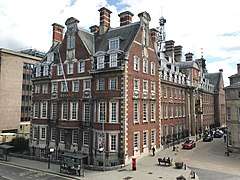
The total length of line owned was 4,990 miles (8,030 km) and the company's share capital was £82 million. The headquarters were at York and the works at Darlington, Gateshead, York and elsewhere.[1]
Befitting the successor to the Stockton & Darlington Railway, the NER had a reputation for innovation. It was a pioneer in architectural and design matters and in electrification. In its final days it also began the collection that became the Railway Museum at York, now the National Railway Museum.
In 1913 the company achieved a total revenue of £11,315,130 (equivalent to £1,121,600,000 in 2019)[2] with working expenses of £7,220,784[3] (equivalent to £715,760,000 in 2019).[2]
During the First World War, The NER lost a total of 1,908 men.[4] They also raised two 'Pals Battalions', the 17th (N.E.R. Pioneer) Battalion and 32nd (N.E.R. Reserve) Battalion, Northumberland Fusiliers. This was the first time that a battalion had been raised from one Company.[5] The company also sent two tug boats, NER No.3.[6] and Stranton[7] The latter became HM Tug Char and was lost at sea on 16 January 1915 with the lost of all hands.[8]
Constituent parts of the NER
_Station_1919921_b387c66e.jpg)
Constituent companies of the NER are listed in chronological order under the year of amalgamation.
Their constituent companies are indented under the parent company with the year of amalgamation in parenthesis.
If a company changed its name (usually after amalgamation or extension), the earlier names and dates are listed after the later name.
The information for this section is largely drawn from Appendix E (pp 778–779) in Tomlinson.[9]
1854
- York, Newcastle and Berwick Railway was York and Newcastle Railway (1846–1847) and Newcastle and Darlington Junction Railway (1842–1846)
- Durham Junction Railway (1844)
- Brandling Junction Railway (1845)
- Durham and Sunderland Railway (1846)
- Pontop and South Shields Railway (1846)
- Stanhope and Tyne Railway (1842)
- Newcastle and Berwick Railway (1847)
- Great North of England Railway (1850)
- York and North Midland Railway
- Leeds and Selby Railway (1844)
- Whitby and Pickering Railway (1845)
- East and West Yorkshire Junction Railway (1852)
- Leeds Northern Railway was Leeds and Thirsk Railway (1845–1849)
- Malton and Driffield Railway
1857
- Deerness Valley Railway
- Hartlepool Dock and Railway
1858
- North Yorkshire and Cleveland Railway
1859
- Bedale and Leyburn Railway
1862
- Hull and Holderness Railway
- Newcastle and Carlisle Railway
- Blaydon, Gateshead and Hebburn Railway (1839)
1863
- Stockton and Darlington Railway
- Darlington and Barnard Castle Railway (1858)
- Middlesbrough and Guisborough Railway (1858)
- Middlesbrough and Redcar Railway (1858)
- Wear Valley Railway (1858)
- Bishop Auckland and Weardale Railway (1847)
- Eden Valley Railway (1862)
- Frosterley and Stanhope Railway (1862)
- South Durham and Lancashire Union Railway (1862)
1865
- Cleveland Railway
- West Hartlepool Harbour and Railway
- Clarence Railway (1853)
- Stockton and Hartlepool Railway (1853)
1866
1870
- West Durham Railway
1872
1874
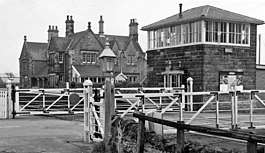
1876
- Hexham and Allendale Railway
- Leeds, Castleford and Pontefract Junction Railway
1882
1883
- Hylton, Southwick and Monkwearmouth Railway
- Scotswood, Newburn and Wylam Railway
1889
1893
- Wear Valley Extension Railway
1898
- Scarborough & Whitby Railway
1900
1914
- Scarborough, Bridlington and West Riding Junction Railway
1922
Dock Companies
1853
- Hartlepool West Harbour and Dock
1857
- Hartlepool Dock and Railway
1893
- Hull Dock Company
Principal stations
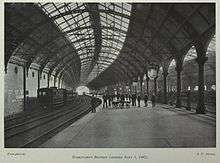
Having inherited the country's first ever great barrel-vault roofed station, Newcastle Central, from its constituent the York Newcastle & Berwick railway, the NER during the next half century built a finer set of grand principal stations than any other British railway company, with examples at Alnwick, Tynemouth, Gateshead East, Sunderland, Stockton, Middlesbrough, Darlington Bank Top, York and Hull Paragon; the rebuilding and enlargement of the last-named resulting in the last of the type in the country. The four largest, at Newcastle, Darlington, York and Hull survive in transport use. Alnwick is still extant but in non-transport use since 1991 as a second-hand book warehouse,[10] the others having been demolished during the 1950s/60s state-owned railway era, two (Sunderland and Middlesbrough) following Second World War bomb damage.
- York station (York) was the hub of the system, and the headquarters of the line was located here. The basis for the present station was opened on 25 June 1877. Until the advent of modern signalling, the 295-lever box was the largest manually worked signal box in Britain.
- Newcastle station (Newcastle), opened on 29 August 1850, became the largest on the NER.
Other principal stations were located at Sunderland, Darlington and Hull. The station at Leeds was a joint undertaking with the London and North Western Railway.
Architects
The NER was the first railway company in the world to appoint a full-time salaried architect to work with its chief engineer in constructing railway facilities. Some of the men appointed were based in, or active in, Darlington.
- George Townsend Andrews was the first architect associated with the North Eastern Railway. He designed the first permanent station at York, along with others on the NER route. He also designed the Assembly Rooms in York.
- Thomas Prosser held the position from 1854 to 1874. He worked in Newcastle.
- Benjamin Burleigh, served for two years, dying in office.
- William Peachey, was based in Darlington, and served for two years. Peachey had been architect to the Stockton and Darlington Railway, and when this merged into the NER in 1863, he was made Darlington section architect. Most of his work was to extend and improve railway buildings. Elsewhere he built the Zetland Hotel at Saltburn (1861–63), and the Royal Station Hotel at York (1877–82). He also practised privately, designing a few nonconformist chapels, including Grange Road Baptist Chapel in Darlington, 1870–1.
- William Bell worked for the NER for 50 years; he was chief architect for 37 years, between 1877 and 1914. His major contributions were as NER architect. Bank Top (1884–87) is one of the best examples of his station designs, for which he developed a standard system of roof building. He added various elements to the North Road Engineering works between 1884 and 1910. With Horace Field, he designed the splendid Headquarters Offices in York in 1904. He also designed the offices of the Mechanical Engineer's Department in Brinkburn Road in 1912, showing that he could adapt his style to the new influences of the Queen Anne revival.
- Arthur Pollard and Stephen Wilkinson each briefly filled the position of chief architect. The merger of the company into the LNER resulted in abolition of the department.
Professional design was carried through to small fixtures and fittings, such as platform seating, for which the NER adopted distinctive 'coiled snake' bench-ends. Cast-iron footbridges were also produced to a distinctive design. The NER's legacy continued to influence the systematic approach to design adopted by the grouped LNER.
Senior staff
Chairmen
- James Pulleine (1854–55)[11]
- Harry Stephen Thompson (1855–74)
- George Leeman (1874–80)
- John Dent Dent (1880–94)
- Sir Joseph Whitwell Pease, Bart (1895–1902)
- Viscount Ridley (1902–04)
- Sir Edward Grey, Bart (1904–05)
- John Lloyd Wharton (1906–12)
- Baron Knaresborough (1912–22)[12]
Directors
A director of the NER from 1864, and deputy chairman from 1895 until his death in 1904, was ironmaster and industrial chemist Sir Lowthian Bell.[13] His son Sir Hugh Bell was also a director; he had a private platform on the line between Middlesbrough and Redcar at the bottom of the garden of his house Red Barns. Gertrude Bell's biographer, Georgina Howell, recounts a story about the Bells and the NER:[14]
As the heirs of the director of the North Eastern Railway, the Hugh Bells were transport royalty. At Middlesbrough the stationmaster doffed his hat to them and ushered them onto the train at Redcar. Many years later, Florence's daughter Lady Richmond was to remember an occasion when she was seeing her father off from King's Cross, and he had remained on the platform so that they could talk until the train left. The packed train failed to leave on time. Remarking on its lateness, they continued to talk until they were approached by a guard. 'If you would like to finish your conversation, Sir Hugh', he suggested, doffing his hat, 'we will then be ready to depart'.
— Georgina Howell[15]
Among the other famous directors of the NER were George Leeman (director 1854–82, Chairman 1874–80); Henry Pease (director 1861–1881); Sir Joseph Whitwell Pease, Bart. (director 1863–1902, Chairman 1895–1902); John Dent Dent (director 1879–94, Chairman 1880–94); Matthew White Ridley, 1st Viscount Ridley (director 1881–1904, Chairman 1902–04); Sir Edward Grey, Bart (director 1885–1911, Chairman 1904–05); George Gibb (solicitor 1882–1891, general manager 1891–1906, director 1906–1910); and Henry Tennant (director 1891–1910).[16]
Electrified lines

The NER was one of the first main line rail companies in Britain to adopt electric traction, the Lancashire and Yorkshire Railway having opened its first electrified line between Liverpool and Southport one week earlier.
Tyneside

The Tyneside scheme commenced public operation on 29 March 1904. The scheme was known as Tyneside Electrics and totalled about 30 miles:[1]
- Newcastle Central via Wallsend, Whitley Bay, Gosforth and New Bridge Street (the Newcastle terminus of the former Blyth & Tyne Railway)
- Heaton to Benton or Backworth via the East Coast Main Line
- Riverside Branch from Byker to Percy Main
- Newcastle Quayside Branch
The latter was electrically operated from June 1905 and was a 3/4 mile freight-only line from Trafalgar Yard, Manors to Newcastle Quayside Yard.
Further extensions taking the electrification to South Shields were carried out in March 1938 by the London and North Eastern Railway
The lines were originally electrified at 600 V DC using the 3rd rail system, although after 1934 the operating voltage was raised to 630 V DC. On the Newcastle Quayside Branch overhead line of tramway type was used for upper and lower yards with 3rd rail in the interconnecting tunnels between the yards.
Newport-Shildon
_(14758510085).jpg)
The Newport-Shildon line was electrified on the 1,500 V DC overhead system between 1914 and 1916 and the locomotives which later became British Rail Class EF1 were used on this section.[17][18]
Traffic
The NER carried a larger tonnage of mineral and coal traffic than any other principal railway.
The NER was a partner (with the North British and the Great Northern Railway) in the East Coast Joint Stock operation from 1860.
Accidents and incidents
- On 6 December 1870, a collision between two trains at Brockley Whins, County Durham killed five people. The accident was caused by a lack of interlocking between points and signals.[19]
- In 1870, a freight train overran signals and collided with a London and North Western Railway passenger train at St. Nicholas Crossing, Carlisle, Cumberland. Five people were killed. The driver of the freight was intoxicated.[19]
- On 27 July 1875, the boiler of a locomotive exploded at Holbeck station, Leeds, Yorkshire.[20]
- On 25 March 1877, an express passenger train was derailed at Morpeth, Northumberland due to excessive speed on a curve. Five people were killed and seventeen were injured.
- In 1877,the boiler of a locomotive exploded at Alne, Yorkshire.[20]
- On 10 August 1880, an express passenger train hauled by a NER locomotive was derailed on the North British Railway near Berwick upon Tweed, Northumberland due to defective track. Three people were killed.[20]
- On 25 October 1887, a freight train overran signals at Chevington, Northumberland and was in a head-on collision with a locomotive that was shunting. That locomotive and its wagons were pushed into a stationary passenger train.[20]
- In 1890, a freight train was derailed on the Redheugh Incline, Gateshead, County Durham.[21]
- On 2 November 1892, an express passenger train was in a rear-end collision with a freight train at Thirsk, Yorkshire due to errors by the guard of the freight train and a signalman. Ten people were killed and 43 were injured.
- On 4 November 1894, a sleeping car train overran signals and collided with a freight train that was being shunted at Castle Hills, Yorkshire. One person was killed.[20]
- On 5 November 1900, a freight train ran away and was derailed by trap points at Lingdale Junction, Yorkshire.[21]
- On 4 July 1901, a freight train was unable to stop and ran off the end of a siding at Harperley, County Durham.[22]
- On 27 June 1905, a freight train was derailed at Wallsend, Northumberland.[21]
- On 24 November 1906, a passenger train overran signals and ran into the rear of a freight train at Ulleskelf, Yorkshire.[21]
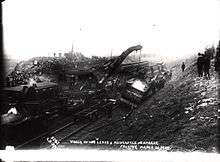
- On 26 March 1907, a passenger train was derailed by heat buckled track at Felling, County Durham (now Tyne and Wear). Two people were killed and six were seriously injured. The accident could have been prevented as the signalman had been warned of the buckle by a member of the public but refused to heed the warning.[21]
- On 28 August 1907, a freight train overran signals and was derailed at Goswick, Northumberland. Two people were killed and one was seriously injured.[23]
- On 8 October 1908, an overloaded freight train ran away and crashed into goods wagons at Masham, Yorkshire.[20]
- On 29 May 1909, a freight train was derailed at Skinningrove, Yorkshire due to subsidence of the trackbed.[20]
- On 8 August 1909, a freight train was derailed at Hartley, Cumberland due to the track buckling in the heat of the sun.[22]
- On 15 November 1910, an express freight train overran signals and was in a rear-end collision with a freight train at Darlington, County Durham.[21]
- On 13 December 1911, a freight train ran away between Rockingham South Signal Box and Wombwell station, Yorkshire, It passed several signals at danger before colliding with wagons being shunted at Darfield Main Signal Box. Both crew of the locomotive were killed.[20]
- On 15 December 1911, a freight train was derailed at Lartington, Yorkshire due to the driver braking too sharply. During recovery operations, a rail-mounted crane overturned.[20]
- On 3 March 1916, an empty stock train was in a rear-end collision with an electric multiple unit at Manors East station, Newcastle upon Tyne, Northumberland. Forty-nine people were injured.[24]
- On 15 September 1917, a set of carriages ran away from Catterick Camp and was derailed. Three people were killed.[21]
- On 11 August 1918, the carriage sheds at Heaton, Newcastle were destroyed by fire, as were 34 carriages forming a number of NER electric units.[20]
- On 14 February 1920, two freight trains were involved in a head-on collision at Skelton, Yorkshire.[21]
- On 31 March 1920, a passenger train was derailed at York station.[21]
- On 22 October 1921, Petrol Inspection Saloon No. 3768 was destroyed by fire at York station.[21]
Docks
The company owned the following docks:
- The Hull Docks Company (Queens dock, Humber Dock, Railway Dock, Victoria dock, Albert dock, William Wright Dock, St Andrews dock): acquired 1893. Dealt with a large variety of cargoes, including grain, seed, wood and fruit
- King George Dock (opened 1914) – jointly operated with the Hull and Barnsley Railway.The Dock was used by the 17th (NER Pioneer) Battalion, Northumberland Fusiliers as a base during its formation in 1915.[5]
- Hartlepool Docks: acquired 1865. A large timber trade
- Tyne Dock: opened by NER in 1859. Timber and coal exports
- Middlesbrough Dock: Opened in 1842. Iron and steel exports; and a worldwide trade in other goods.
The NER also owned coal-shipping staithes at Blyth and Dunston-on-Tyne. Its steamboats ran between Hull and Antwerp and other places on the Continent.[1]
Locomotives
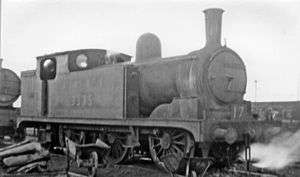

_Locomotive_Depot_geograph-2380330-by-Ben-Brooksbank.jpg)
A comprehensive list of NER locomotives: Locomotives of the North Eastern Railway.
Coaching stock
The NER originally operated with short four and six wheeled coaches with a fixed wheelbase. From these were developed the standard 32-foot (9.8 m) six-wheeled, low elliptical roofed coaches which were built in their thousands around the 1880s. One variety alone, the diagram 15, five compartment, full 3rd class, numbered around a thousand. The NER started building bogie stock for general service use in 1894, 52-foot (16 m) clerestories for general use with a 45-foot (14 m) variation built for use on the tightly curved line from Malton to Whitby. There were also a series of 49-foot (15 m) low ark roofed bogie coaches (with birdcage brakes) for use on the coast line north of Scarborough. Coach manufacture moved to high arched roof vehicles but with substantially the same body design in the early 1900s.
The NER had limited need for vestibuled coaches but from 1900 built a series of vestibuled, corridor coaches with British Standard gangways, for their longer distance services. The company introduced clerestory corridor dining trains on services between London and Edinburgh. The initial trial was run between York and Newcastle in 1 hour 30 minutes on 30 July 1900.[25] The new train consisted of eight coaches and was 499.5 feet (152.2 m) long (excluding the engine), and had seating for 50 first-class and 211 third-class passengers. At the same time they built (in conjunction with their partners) similar coaches for the East Coast Joint Stock (GNR/NER/NBR) and the Great Northern and North Eastern Joint Stock.
All NER coach building was concentrated at their York Carriage Works, which went on to be the main LNER carriage works after grouping.
With the introduction of the standard 32-foot (9.8 m) 6-wheeled coaches NER carriage livery was standardised as 'deep crimson' (a deeper colour with more blue in it than that used by the Midland Railway), lined with cream edged on both sides with a thin vermillion line. For a time the cream was replaced with gold leaf. Lettering ('N.E.R.' or when there was sufficient space 'North Eastern Railway' in full, together with 'First', 'Third' and 'Luggage Compt.' on the appropriate door) and numbering; was in strongly serifed characters, blocked and shaded to give a 3D effect.
The NER's bogie coach building programme was such that, almost unique amongst pre-grouping railways, they had sufficient bogie coaches to cover normal service trains; six wheel coaches were reserved for strengthening and excursion trains.
See also
- North Eastern Railway War Memorial, memorial to the company's employees killed in the First World War, located outside its former head office in York
References
- Harmsworth (1921)
- UK Retail Price Index inflation figures are based on data from Clark, Gregory (2017). "The Annual RPI and Average Earnings for Britain, 1209 to Present (New Series)". MeasuringWorth. Retrieved 2 February 2020.
- "North-Eastern Railway". Yorkshire Post and Leeds Intelligencer. British Newspaper Archive. 21 February 1914. Retrieved 1 August 2016 – via British Newspaper Archive.
- "North Eastern Railway Roll of Honour - War Memorials Online". www.warmemorialsonline.org.uk. Retrieved 12 July 2020.
- Shakespear, Lt. Col. A Record of the 17th and 32nd Battalions Northumberland Fusiliers 1914-1919 (N.E.R.) Pioneers. Unit 10, Ridgewood Industrial Park, Uckfield, East Sussex, TN22 5QE, England: The Naval & Military Press Ltd. pp. 1–14. ISBN 9781843426875.CS1 maint: location (link)
- "Tyne tug NER No 3 1915". www.tynetugs.co.uk. Retrieved 12 July 2020.
- "Tyne tug Stranton Char screw tug 1899". www.tynetugs.co.uk. Retrieved 12 July 2020.
- "Hartlepool History Then & Now". www.hhtandn.org. Retrieved 12 July 2020.
- Tomlinson, W.W. (1967) [1914]. North Eastern Railway, Its Rise and Development. Newton Abbot: David and Charles.
- "Barter Books Shop History". Bartr Books – About us. Barter Books. Retrieved 6 November 2015.
- Tomlinson 1915, p. 771
- Allen 1974, p. 229
- NEIMME: Sir Isaac Lowthian Bell, Bart Archived 17 August 2011 at the Wayback Machine. Retrieved 28 November 2012.
- Howell 2008, pp. 7, 13
- Howell 2008, pp. 13
- Tomlinson 1915, pp. 768–770
- "The NER Electric Bo-Bo Class EF1 & EB1 Locomotives". Lner.info. Retrieved 7 September 2013.
- Appleby, K.C. (1990). Shildon to Newport in Retrospect. Railway Correspondence & Travel Society. ISBN 0-901115-67-3.
- Hall, Stanley (1990). The Railway Detectives. London: Ian Allan. p. 40. ISBN 0 7110 1929 0.
- Hoole, Ken (1983). Trains in Trouble: Vol. 4. Truro: Atlantic Books. pp. 8, 15–16, 20, 24, 27, 31–32, 45. ISBN 0-906899-07-9.
- Hoole, Ken (1982). Trains in Trouble: Vol. 3. Redruth: Atlantic Books. pp. 8, 12–17, 22, 24. ISBN 0-906899-05-2.
- Earnshaw, Alan (1989). Trains in Trouble: Vol. 5. Penryn: Atlantic Books. pp. 5, 10–11. ISBN 0-906899-35-4.
- Trevena, Arthur (1981). Trains in Trouble: Vol. 2. Redruth: Atlantic Books. p. 25. ISBN 0-906899-03-6.
- Earnshaw, Alan (1993). Trains in Trouble: Vol. 8. Penryn: Atlantic Books. p. 7. ISBN 0-906899-52-4.
- "New Corridor Train". Sunderland Daily Echo and Shipping Gazette. British Newspaper Archive. 31 July 1900. Retrieved 20 August 2016 – via British Newspaper Archive.
Sources
- Allen, Cecil J. (1974) [1964]. The North Eastern Railway. Shepperton: Ian Allan. ISBN 0-7110-0495-1.CS1 maint: ref=harv (link)
- British Railway Electrics (Ian Allan, 1960 edition)
- Conolly, W. Philip (2004). British Railways Pre-Grouping Atlas and Gazetteer. Hersham: Ian Allan Publishing. ISBN 0-7110-0320-3.
- Cook, R.A. & Hoole, K. (1991) North Eastern Railway Historical Maps. Railway & Canal Historical Society. ISBN 0-901-461-13-X
- Harmsworth’s Universal Encyclopedia. 1921.
- Howell, Georgina (2008). Gertrude Bell: Queen of the Desert, Shaper of Nations. Farrar, Straus and Giroux.CS1 maint: ref=harv (link)
- North Eastern Railway at LNER Encyclopedia
- North Eastern Railway and its constituents at Steam Index. Notes on locomotive classes with references to appropriate publications.
- Railway Magazine February & March 1923 editions
- Railway Year Book for 1912 (Railway Publishing Company)
- Tomlinson, W.W. (1915). The North Eastern Railway: Its Rise and Development. Newcastle-upon-Tyne: Andrew Reid and Company.CS1 maint: ref=harv (link) Reprinted as Tomlinson's North Eastern Railway. Newton Abbot: David and Charles, 1967.
Further reading
- Addyman, J.F., ed. (2011). A History of the Newcastle & Berwick Railway. North Eastern Railway Association. ISBN 978-1-873513-75-0.
- Addyman, J.F.; Fawcett, B., eds. (2013). A History of the Hull & Scarborough Railway. Kestrel. ISBN 978-1-905505-30-2.
- Addyman, J.F.; Mallon, J.F., eds. (2007). The Alnwick & Cornhill Railway. North Eastern Railway Association. ISBN 978-1-873513-65-1.
- Bell, R. (1951). Twenty-five years of the North Eastern Railway, 1898–1922. London: Railway Gazette.
- Couthard, R.B.; Teasdale, J.G. (2018). Lesser Railways Around Darlington. North Eastern Railway Association. ISBN 978-1-911360-13-1.
- Fawcett, B. (2001). A history of North Eastern Railway architecture (three volumes, 2001, 2003, 2005). North Eastern Railway Association.
- Grafton, P. (2005). Sir Vincent Raven and the North Eastern Railway. Usk: Oakwood Press.
- Hoole, K. (1988). An illustrated history of NER locomotives. Sparkford: Oxford Publishing.
- Hoole, K. (1979). The 4-4-0 classes of the North Eastern Railway. London: Ian Allan.
- Hoole, K. (1988). The electric locomotives of the North Eastern Railway. Oxford: Oakwood Press.
- Hoole, K. (1961). The North Eastern electrics. Lingfield: Oakwood Press.
- Hoole, K. (1965). The North-Eastern Atlantics. Hatch End: Roundhouse.
- Hoole, K. (1967). North Road Locomotive Works, Darlington, 1863–1966. Hatch End: Roundhouse.
- Irving, R.J. (1976). The North Eastern Railway Company, 1870–1914: an economic history. Leicester: Leicester University Press.
- Mackay, A.N., ed. (2016). A History of North Eastern Railway Signalling. North Eastern Railway Association. ISBN 978-1-873513-99-6.
- MacLean, J.S. (2014) [Newcastle: R. Robinson & Co., c. 1923]. The locomotives of the North Eastern Railway, 1841–1922 (reprint ed.). Stroud: Amberley Publishing.
- Maynard, P.J. (2015). North Yorkshire & Cleveland Railway. North Eastern Railway Association. ISBN 978-1-873513-98-9.
- Nock, O.S. (1954). Locomotives of the North Eastern Railway. London: Ian Allan.
- Teasdale, J.G., ed. (2007). Servicing the North Eastern Railway's Locomotives. North Eastern Railway Association. ISBN 978-1-873513-62-0.
- Tuplin, W.A. (1970). North Eastern Steam. London: Allen & Unwin.
- Williamson, C.; Williamson, D. (2014). Railway Snow Ploughs in the North East. North Eastern Railway Association. ISBN 978-1-873513-88-0.
- Williamson, C.; Williamson, D.; Grocock, M. (2008). A Portrait of the North Eastern Railway. North Eastern Railway Association. ISBN 978-1-873513-58-3.
External links
| Wikimedia Commons has media related to North Eastern Railway. |